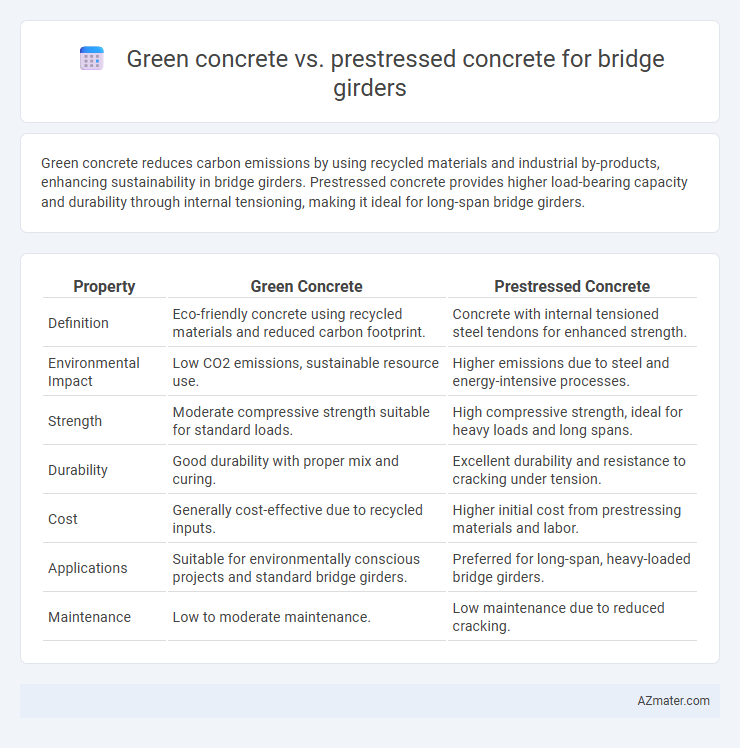Green concrete reduces carbon emissions by using recycled materials and industrial by-products, enhancing sustainability in bridge girders. Prestressed concrete provides higher load-bearing capacity and durability through internal tensioning, making it ideal for long-span bridge girders.
Table of Comparison
| Property | Green Concrete | Prestressed Concrete |
|---|---|---|
| Definition | Eco-friendly concrete using recycled materials and reduced carbon footprint. | Concrete with internal tensioned steel tendons for enhanced strength. |
| Environmental Impact | Low CO2 emissions, sustainable resource use. | Higher emissions due to steel and energy-intensive processes. |
| Strength | Moderate compressive strength suitable for standard loads. | High compressive strength, ideal for heavy loads and long spans. |
| Durability | Good durability with proper mix and curing. | Excellent durability and resistance to cracking under tension. |
| Cost | Generally cost-effective due to recycled inputs. | Higher initial cost from prestressing materials and labor. |
| Applications | Suitable for environmentally conscious projects and standard bridge girders. | Preferred for long-span, heavy-loaded bridge girders. |
| Maintenance | Low to moderate maintenance. | Low maintenance due to reduced cracking. |
Introduction: The Evolution of Bridge Girders
Bridge girders have evolved significantly to enhance durability and sustainability in infrastructure projects. Green concrete, utilizing eco-friendly materials like fly ash and slag, reduces carbon footprint while maintaining structural integrity. In contrast, prestressed concrete incorporates high-strength steel tendons to counteract tensile stresses, enabling longer spans and improved load-bearing capacity.
Defining Green Concrete: Materials and Benefits
Green concrete incorporates industrial by-products such as fly ash, slag, and recycled aggregates to reduce environmental impact while maintaining structural integrity. Its use in bridge girders offers enhanced sustainability through lower carbon emissions and improved durability due to reduced permeability and increased resistance to chemical attacks. This eco-friendly material also promotes resource efficiency and aligns with global efforts to minimize construction-related ecological footprints.
Understanding Prestressed Concrete: Key Attributes
Prestressed concrete for bridge girders incorporates high-strength steel tendons tensioned before or after casting to counteract tensile stresses, enhancing load-bearing capacity and durability. This method reduces cracking, increases span length capabilities, and improves overall structural efficiency compared to traditional green concrete, which primarily emphasizes ecological benefits like lower carbon footprint but often lacks the mechanical advantages of prestressing. Understanding prestressed concrete's key attributes reveals its superior performance in demanding bridge applications, balancing strength, serviceability, and long-term resilience.
Sustainability Factors: Green vs Prestressed Concrete
Green concrete incorporates recycled materials and industrial by-products, significantly reducing carbon emissions and energy consumption compared to traditional materials, making it a sustainable choice for bridge girders. Prestressed concrete offers superior strength and durability, enabling longer spans and reduced material usage, which can indirectly contribute to sustainability by lowering resource demand. Selecting between green and prestressed concrete depends on balancing environmental impact, structural requirements, and lifecycle performance in bridge girder applications.
Mechanical Strength and Durability Comparison
Green concrete, incorporating recycled materials and industrial by-products, offers comparable compressive strength to traditional concrete but generally exhibits slightly lower tensile strength than prestressed concrete used for bridge girders. Prestressed concrete girders provide superior mechanical strength due to the application of pre-tensioned or post-tensioned steel tendons, enhancing load-bearing capacity and crack resistance under dynamic loads. Durability-wise, green concrete demonstrates improved resistance to environmental degradation and reduced carbon footprint, while prestressed concrete benefits from reduced crack widths that enhance long-term durability in aggressive exposure conditions.
Environmental Impact Assessment
Green concrete significantly reduces the carbon footprint of bridge girders by incorporating recycled materials and industrial by-products such as fly ash or slag, which lower CO2 emissions during production compared to traditional prestressed concrete. Prestressed concrete, while offering superior structural performance and durability, typically involves higher energy consumption and greenhouse gas emissions due to the extensive use of cement and steel tendons. Environmental Impact Assessment favors green concrete for sustainable bridge construction by minimizing natural resource depletion and promoting waste reutilization without substantially compromising strength.
Cost Analysis: Initial Investment and Lifecycle
Green concrete for bridge girders typically involves a higher initial investment due to sustainable materials and admixtures that reduce carbon emissions, yet offers long-term savings through energy-efficient production and reduced environmental compliance costs. Prestressed concrete demands considerable upfront costs for specialized reinforcement and tensioning processes, but enables longer spans with reduced material use and maintenance expenses, optimizing lifecycle performance. When comparing lifecycle costs, green concrete's environmental benefits often translate into regulatory incentives and potential carbon credits, while prestressed concrete provides superior durability and load capacity, influencing overall project economics.
Construction Techniques and Challenges
Green concrete utilizes supplementary cementitious materials such as fly ash and slag to reduce carbon footprint while maintaining adequate strength, posing challenges in curing time and mixture consistency during bridge girder casting. Prestressed concrete girder construction involves tensioning high-strength steel tendons before or after casting to enhance load-bearing capacity, requiring precise control over prestressing forces and anchorage systems to prevent structural failures. Both techniques demand specialized equipment and skilled labor, with green concrete emphasizing sustainable material handling and prestressed concrete focusing on tensioning accuracy and quality assurance.
Case Studies: Bridge Girders Using Green and Prestressed Concrete
Case studies comparing green concrete and prestressed concrete for bridge girders demonstrate significant environmental and structural performance differences. Bridges using green concrete, which incorporates recycled materials and reduces carbon emissions, show promising durability and sustainability in varied climates. Prestressed concrete girders continue to excel in load-bearing capacity and long-span efficiency, making them ideal for heavy traffic and large infrastructure projects.
Future Trends in Bridge Girder Design
Green concrete, utilizing industrial by-products like fly ash and slag, significantly reduces carbon footprint and enhances durability, making it a promising choice for sustainable bridge girder design. Prestressed concrete, with its superior load-bearing capacity and crack control, remains essential for long-span bridge girders but is increasingly integrated with eco-friendly materials to meet environmental standards. Future trends emphasize hybrid designs combining the sustainability of green concrete with the structural efficiency of prestressed systems, supported by advances in material science and construction technology.

Infographic: Green concrete vs Prestressed concrete for Bridge girder
 azmater.com
azmater.com